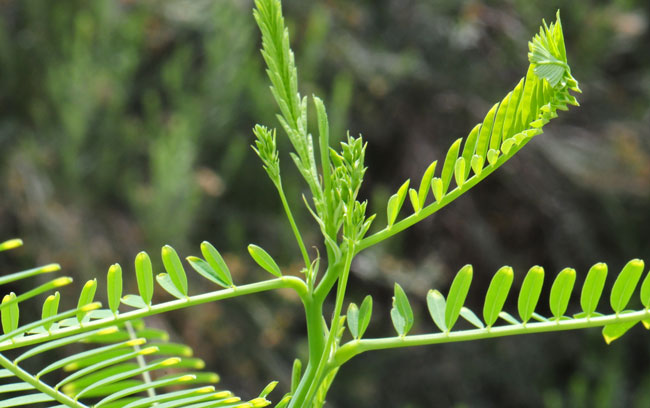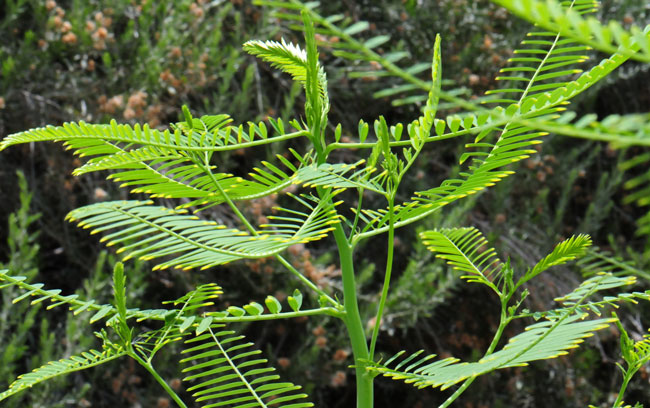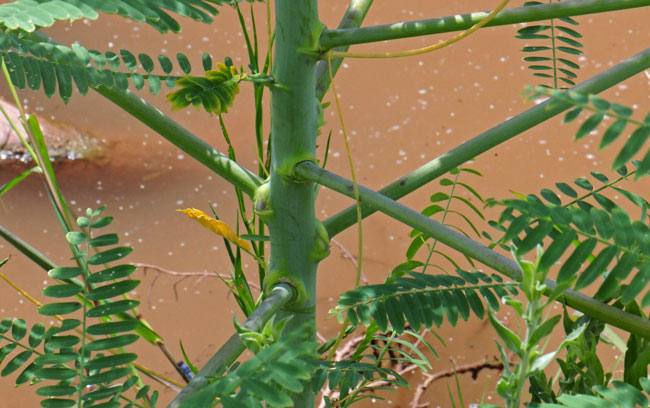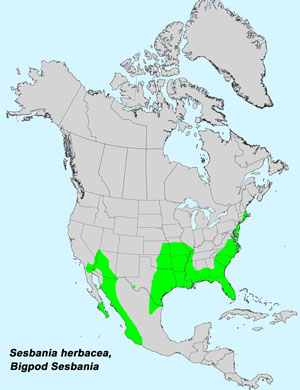Sesbania herbacea, Bigpod Sesbania



Scientific Name: Sesbania herbacea
Common Name: Bigpod Sesbania
Also Called:Big-pod Sesbania, Big-podded Sesbania, Coffee Bean, Coffeeweed, Colorado River Hemp, Colorado River-hemp, Danglepod, Egyptian River-hemp, Hemp Sesbania, Long-pod Sesban, Long-pod Sesbania, Long-podded Sesban, Peatree, Sesbania, Tall Indigo, Wild Hempsesbania, Wild Hemp-sesbania (Spanish: Baiquillo, Baiguiyo)
Family: Fabaceae or Leguminosae Family
Synonyms: (Aeschynomene emerusmm, Darwinia exaltata, Sesban emerus, Sesbania emerus, Sesban exaltatus, Sesbania exaltata, Sesbania macrocarpa, Sesbania sesban)
Status: Native and also introduced.
Duration: Annual, perennial;
Size: 3 to 9 feet (.91-2.7 m) or so.
Growth Form: forb/herb, Subshrub; semi-woody, stems glabrous branches freely wide-spread.
Leaves: Green, bright green; large leaves up to 1 foot (.3 m) long, pinnately compound, leaflets, oblong.
Flower Color: Yellow or yellow-orange with flecks of purple or brown; pea-like flower, 2 to 6 bell shaped flowers; fruit is a linear pod.
Flowering Season: March or April and later, to October across it's wide geographic range.
Elevation: Up to 1,500 feet (457 m) or higher.
Habitat Preferences: Around irrigation ditches, moist habitats and year-round streams; alluvial soils.
Recorded Range: South central United States and southwest states; AL, AR, AZ, CA, FL, GA, IL, KS, KY, LA, MA, MD, MO, MS, NC, NY, OK, PA, TN, TX and VA. Although listed as a native in North America, Bigpod Sesbania is possibly native only the southeastern states where moisture is abundant and introduced elsewhere. Also native throughout Mexico.
North America & US County Distribution Map for Sesbania herbacea.
North America species range map for Bigpod Sesbania, Sesbania herbacea:

U.S. Weed Information: Considered a weed in Arizona.
Invasive/Noxious Weed Information: Sesbania herbacea is listed as a Noxious Weed by the State of Arkansas, Sesbania exaltata, Tall Indigo, Coffee Bean, Noxious Weed. Plants included here are invasive or noxious.
International Invasive/Noxious Weed Information: 1The Centre for Agriculture and Bioscience International, (CABI), and 2The Invasive Species Compendium (ISC) has identified Sesbania herbacea as an “Invasive Species and Host Plant”.
1The Centre for Agriculture and Bioscience International (CABI), Wallingford, Oxfordshire, England; The US Department of Agriculture is a lead partner with CABI.
2The Invasive Species Compendium (ISC) is an encyclopedic resource that brings together a wide range of different types of science-based information to support decision-making in invasive species management worldwide.
Wetland Indicator: In North America Sesbania herbacea has the following wetland designations;
FACW = Facultative Wetland, usually occur in wetlands, but may occur in non-wetlands
FAC = Facultative, occur in wetlands and non-wetlands
Threatened/Endangered Information: Unknown
Genus Information: In North America, USDA Plants Database lists 16 species and accepted taxa overall for Sesbania. Worldwide, World Flora Online includes 144 accepted species names and a further 31 scientific names of infraspecific rank for the genus.
The genus Sesbania (Sesban'ia:) was published by Michel Adanson in 1763.
In the Southwestern United States: Arizona has 1 species of Sesbania, California has 2 species, Nevada, New Mexico and Utah have 0 species and Texas has 5 species. Data approximate, subject to revision.
Comments: Bigpod Sesbania is listed as a native species in the United States and also considered an invasive species in certain locations including Arizona.
In the past Bigpod Sesbania has been used as a soil-improvement crop on farms in the southwest. It is a fiber plant and produces strong threads and have apparently been used by Southwest Arizona Native Americans for nets and fish lines (Arizona Flora). This plant is toxic to livestock.
The genus Sesbania (Sesban'ia:) was published by Michel Adanson in 1763.
The species epithet “herbacea” (herba'cea:) means herbaceous and not woody.
The current taxon “Sesbania herbacea” was described in 1987 by Rogers McVaugh (1909-2009).
The original taxon “Emerus herbacea” was described in 1768 by Philip Miller, (1691-1771).

